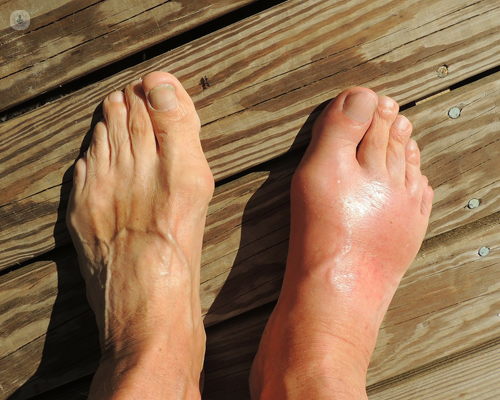Take a load off from foot arthritis
Written by:The painful symptoms that come with foot arthritis can be frustrating and sometimes, they can feel like they’re never ending. However, it’s reassuring to know that there are a variety of ways to relieve it.
Highly experienced consultant orthopaedic foot and ankle surgeon Mr Barry Rose speaks to Top Doctors about arthritis in the feet, how it’s addressed and most importantly, what this can mean for patients looking for long-term solutions.

What exactly is foot arthritis?
Foot arthritis is degeneration, or wear and tear, of any of the joints within the foot. Commonly affected areas include the ankle, the mid foot or the forefoot, including the big toe.
What are the main symptoms?
Most of the time patients will describe the pain in the foot as the main symptom of arthritis.
They would normally be able to localise this to a particular spot that is painful on movement or activity. Often the pain settles with rest. It’s common for the affected joint to also be stiffer than usual and often, but not always, patients will notice this.
What are the main causes?
We don’t always know the cause of arthritis within joints of the foot and ankle. Following a break, such as a broken ankle, there is a risk of developing degenerative change (post-traumatic osteoarthritis). However, not every break leads to the development of arthritis. Equally, osteoarthritis (wear and tear) may develop without any history of break or injury to the effective joint.
Apart from osteoarthritis, there are several other forms of arthritis such as rheumatoid arthritis that may cause pain in any joints within the foot and ankle. Often these will be associated with multiple joint aches and pains.
The disease process in this situation is somewhat different but the surgical management of arthritis in the feet is often similar if medicine cannot control the symptoms.
When is foot arthritis considered to be serious or severe?
We would consider foot arthritis to be serious or severe when a patient is unable to manage the pain by simple measures. These, in the first instance, would usually include:
- The use of painkillers, (either tablets or topical creams);
- Changing to comfortable shoe wear;
- And activity modification to reduce any particular provocative activities, for example walking on uneven ground.
In many instances the use of insoles can help, and physiotherapy can be beneficial.
Is surgery ever required? If so, when?
If the symptoms cannot be managed by such measures, and the pain is unremitting, affecting day-to-day activities and significantly reducing quality of life, injections or surgery may well be indicated.
There is a significant amount of differing surgical options available to treat arthritic change within the foot and ankle depending on:
- The joint affected
- The severity of the degeneration, and;
- The activity level of the individual themselves.
Differing treatments come with variable recovery periods but many of them offer excellent outcomes to significantly improve pain in individuals, and restore their quality of life.
If you’re considering treatment for foot arthritis, or a wide range of foot and ankle conditions, visit Mr Rose’s Top Doctors profile to arrange an appointment with this expert specialist.


